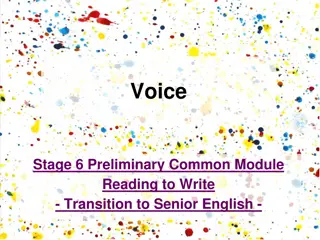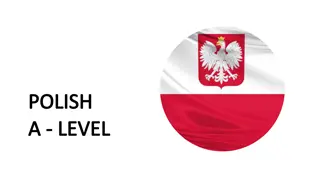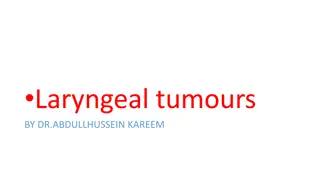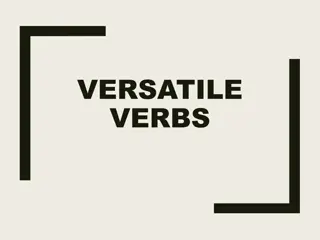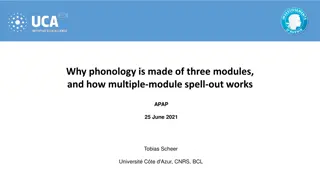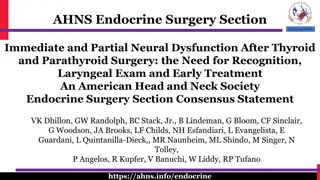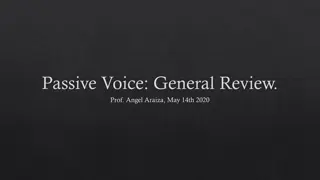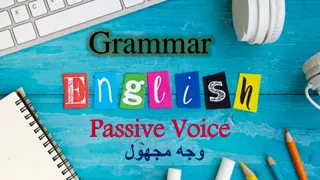Voice Quality in Polish Laryngeal Contrast
Examining the role of voice quality in the laryngeal contrast of Polish, this research delves into the phonological complexities and perceptions of voice contrasts in the Polish language. It compares traditional binary approaches to newer unary approaches, discussing implications and challenges in representing two-way laryngeal contrasts in obstruents.
Download Presentation

Please find below an Image/Link to download the presentation.
The content on the website is provided AS IS for your information and personal use only. It may not be sold, licensed, or shared on other websites without obtaining consent from the author.If you encounter any issues during the download, it is possible that the publisher has removed the file from their server.
You are allowed to download the files provided on this website for personal or commercial use, subject to the condition that they are used lawfully. All files are the property of their respective owners.
The content on the website is provided AS IS for your information and personal use only. It may not be sold, licensed, or shared on other websites without obtaining consent from the author.
E N D
Presentation Transcript
The role of voice quality in the Polish laryngeal contrast Geoff Schwartz, Maral Asiaee, Kamil Ka mierski & Ewelina Wojtkowiak Adam Mickiewicz University in Pozna APAP 2023, Lublin 2
Outline Background on laryngeal phonology Previous phonological descriptions Phonetic complexity of voice contrasts Our working hypothesis and phonological interpretation [fortis] is active in the phonology of Polish, [voice] is not Phonation in the word-initial voice contrast in Polish Phonation in Polish listeners perception of the (incompletely) neutralized word-final voice contrast 3
Voice contrasts in two-way systems Often described in terms of VOT (Lisker and Abramson 1964); aspiration languages: aspirated /ptk/ and short-lag, unvoiced /bdg/ - e.g. Germanic languages, notably English true-voice languages: plain voiceless /ptk/ and pre-voiced /bdg/ - e.g. Slavic languages, such as Polish How should we represent two-way laryngeal contrasts in obstruents? Different theories propose different solutions; How important is the actual phonetic implementation of voicing? That depends on the approach 4
Binary approach The traditional view (Beckman et al. 2013); Binary feature values: [+voice] and [-voice]; phonetic implementation of contrast not important for the underlying representation. Important implications: Aspirated and plain voiceless stops both described in terms of [-voice] Pre-voiced and unvoiced stops both described in terms of [+voice] [p ] and [p] [b] and [b ] phonologically equivalent 5
Unary approach Direct encoding of the VOT typology Often referred to as laryngeal realism a name coined by Patrick Honeybone but the ideas were not so new: Language Series Lombardi (1991) Harris (1994) Honeybone (2005) English /p, t, k/ [aspiration] {H} |spread| /b, d, / Polish /p, t, k/ /b, d, / [voice] {L} |voice| 6
Unary approach Issues with Laryngeal Realism : ignores laryngeal cues other than VOT (e.g. f0, F1 transition), which tend to show parallel behavior in voicing and aspiration systems (Kirby & Ladd 2016; Schwartz et. 2019); Languages like Swedish with both pre-voicing and aspiration (how to motivate overspecification); Does not predict active [-voice] in true-voice languages, but see e.g.; Polish: Rubach (1996), Cyran (2014) for sandhi-voicing dialects Hungarian: Blaho (2008) Breton: Iosad (2012) Dutch: van der Hulst (2015) Moro: Bennet and Rose (2017) Bakairi, Japanese, Azerbaijani, Western Bade ( ri 2023) 7
The complexity of laryngeal contrasts Here is a collection of cues that are relevant for two-series contrasts VOT duration of burst/frication amplitude of burst/frication duration of preceding vowel duration of following vowel f0(pitch) at vowel onset/offset F1 transition The weight of these cues can vary systematically across languages VOT is a more reliable cue in English than Polish (Keating 1980) French: f0 is more reliable than F1 transition; Polish: F1 more reliable than f0 8
The complexity of laryngeal contrasts The complexity of two-series laryngeal contrasts complicates accounts using [voice], which suggests a single phonetic property Rather, a wide range of phonetic cues can signal the presence of a more abstract feature, let s call it [fortis] English: the connection between the laryngeal contrast and voice quality is fairly well-documented glottal reinforcement/replacement of [fortis] creaky phonation some evidence for breathiness induced by lenis codas (Sanker 2019) what about in true voice languages such as Polish? 9
The present study Hypothesis: voice quality is a correlate of the voicing contrast in Polish Fortis consonants should induce stiffer phonation on neighboring vowels Listeners should be sensitive to these effects We present data from two experiments on Polish one on the production of the laryngeal contrast in word-initial position the other on the perception of the (incompletely) neutralized contrast in word- final position 10
Study 1 11
Production of initial voicing contrast in Polish Research Question: does the voicing of initial consonants have an effect on the voice quality in the following vowel? In other words, is the vowel in pas produced with a stiffer voice quality than the vowel in bas? 12
Methods 15 monolingual Polish speakers All females, aged 17-38 (median age: 25); The dataset: 48 Polish plosive-initial words, counterbalanced for voicing (24 voiced, 24 voiceless) and POA (16 labial, 16 coronal, 16 dorsal); Followed by a non-high vowel Mono- or di-syllabic Stimuli presented using PowerPoint slides; Participants recorded directly onto laptop, using a USB interface and a head-mounted mic in a quiet room 13
Methods (cont) Annotated by hand in Praat (Boersma and Weenink 2022) Measurements extracted using Praat scripts: Script 1: VOT duration Script 2: F1 (in Bark difference; F1-f0) and f0 (in Hz) from the first 20% of the vowel Acoustic measures of voice quality using VoiceSauce (Shue et al 2011) Data frames every 1 ms throughout vowel following onset consonant Spectral tilt measures: H1*-H2*, H2*-H4*, H4* H2kHz*, H2kHz* H5kHz Statistical analysis: R version 4.0.4 (R Core Team 2021) Mann-Whitney U test was performed to find out whether spectral tilt values in vowels differ after voiced as opposed to voiceless obstruents 14
Methods (cont) Spectral tilt Spectral tilt refers to the relative amplitude of different harmonics in the vocal wave H1*-H2* - amplitude of 1stharmonic minus amplitude of 2nd H2*H4* - amplitude of 2ndminus amplitude of 4thharmonic H4*H2K* - amplitude of 2ndminus amplitude of harmonic nearest 2000 Hz. H2K*-H5k amplitude of harmonic nearest 2000Hz harmonic nearest 5000 Hz Asterisks mean measures corrected for vowel quality In general, larger differences associated with slacker phonation, smaller (and negative) differences for stiffer phonation 15
Methods (cont) Spectral tilt bas (left) and pas (right) spectrum of vowel 16
Results traditional cues As far as the parameters traditionally associated with laryngeal contrasts: VOT: F1(F1-f0 in Bark) & f0 (Hz) Series VOT (ms) Std Deviation Parameter Onset Average voiceless 41.70ms 16 voiceless 4.9 Bark F1 (F1-f0; Bark) voiced -92.05ms 26 voiced 4.4 Bark voiceless 195 Hz f0 (Hz) voiced 186.6 Hz VOT: voiceless stops slightly aspirated; pre-voicing very common The effects of underlying voicing were detectable in both the f0 (p=.019) and F1 (p=.003) parameters 17
Results voice quality Voice quality results: small but significant effects in all four measures Stiffer phonation for [fortis] in green; Less stiff in yellow Spectral tilt measures Voiceless Voiced H1*-H2* 6.22 (9.93) 5.98 (10.6) H2*-H4* 3.14 (15.1) 5.68 (16.8) H4* H2kHz* 9.60 (15.4) 10.8 (12.5) H2kHz* H5kHz 19.8 (23.8) 15.8 (20.4) 18
Results Interim summary Hypothesis partially supported, depending on the measure you look at More research is needed to determine the relative weight of individual voice quality measures for Polish 19
Study 2 20
Introduction Schwartz et al. 2018, 2021: production study of final devoicing using nonce words and and a purely auditory singular formation task Deals with orthography issue in studying final devoicing (cf. Roettger et al. 2014) speaker hears: Szeby/szepy wyst puj w Warszawie speaker says: A w Poznaniu jest tylko jeden szeb/szep Evidence for incomplete neutralization (IN), answering common critiques of IN studies Schwartz et al. 2018 Perception test using stimuli from production study Listener hears: szeb/szep Listener chooses between two plurals: szeby/szepy Stimuli with normalized vowel and closure durations 79 listeners, over 80% accuracy rate !! (OMG) 89% accuracy for underlying voiceless, 72% for underlying voiced 21
Methods Repeat, over 80% accuracy rate; and the standard cues for final voice contrasts (vowel and closure duration) were controlled for! We were surprised, so we performed more detailed acoustic analysis on the stimuli, including . . . f0 (pitch) burst duration F1 at vowel offset Acoustic meaures of voice quality Voice quality measures performed in VoiceSauce 22
Methods statistical analysis First, the acoustic differences between voiced-voiceless pairs in the stimuli were calculated, the magnitudes of those differences were plugged in as predictors of accuracy positive difference (in expected direction; e.g. pitch higher for underlyingly voiceless consonants) pitch, F1, burst duration, plus 6 voice quality measures Then a Principal Components Analysis (PCA) was performed in R to try to identify which acoustic parameters A significant interaction found between Component 3 and underlying voicing Negative values of Component 3 increased listener accuracy for underlying voiceless consonants; no effect for underlying voiced 23
Results interacation with underlying voicing 24
Results measures in blue: improved accuracy; measures in red: hindered accuracy 25
Results summary of PCA analysis f0 (pitch) and two voice quality measures (CPP; H1*-H2*) did not contribute to accuracy Four voice quality measures (H2*-H4*, H4*-H2K*, H1*-A2, H1*-A3) as well as burst duration and F1 did contribute to accuracy H4*-H2K* had the largest effect, followed by H1*-A3 (A3: harmonic nearest the third formant) 26
Summary of the results of both studies Voice quality on neighboring vowels is an additional phonetic correlate of the voice contrast in Polish consonants; H2*-H4* and H4*-H2K*Hz played a role in both the initial and final contrast; H1*-H2*, however, did not play a role in either position A question for further research H1*-H2* has well-documented effects in languages with phonological phonation contrasts, but apparently not in Polish Could it be the case that in a language like Polish H1*-H2* plays more of a role for speaker identification, while the other measures have more weight for the laryngeal contrast? Voice quality research is challenging, but exciting 27
Implications for two-series laryngeal contrast More research is needed, but it appears voice quality is a phonetic ingredient in two-series laryngeal contrasts, even in so-called voicing languages like Polish This is all compatible with a growing body of evidence that in voicing languages, a [fortis] feature is active, but a feature [voice] does not have to be Blaho (2008), Iosad (2012), Cyran (2014), van der Hulst (2015), ri (2023) Stiffer voice quality appears to be an additional phonetic cue to this feature [fortis], along with things like pitch and F1 transitions Laryngeal features are substance-free, which is why the contrasts may be so phonetically complex 28
Thank you for listening Email us for references: geoff@amu.edu.pl, marasi@amu.edu.pl, kamil.kazmierski@amu.edu.pl, ewelina.wojtkowiak@amu.edu.pl 29




